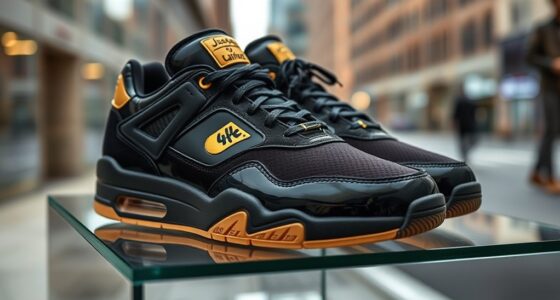Luxury fashion sets itself apart from fast fashion through exceptional craftsmanship, high-quality materials, and exclusive designs that are often handcrafted with attention to detail. It’s rooted in a rich heritage and limited availability, boosting its prestige and perceived value. Ethical sourcing and sustainability also play a key role. If you want to discover how these factors create timeless pieces that symbolize success and artistry, there’s much more to explore below.
Key Takeaways
- Luxury fashion emphasizes exceptional craftsmanship, high-quality materials, and artistic storytelling, unlike fast fashion’s focus on trends and quick production.
- Designer brands prioritize artisanal techniques, limited editions, and exclusivity, whereas fast fashion relies on mass manufacturing and rapid turnover.
- Heritage, legacy, and brand identity are central to luxury labels, fostering emotional value; fast fashion lacks historical depth and artisanal roots.
- Sustainability and ethical practices are integral to luxury fashion, contrasting with fast fashion’s often less transparent, environmentally impactful production.
- Luxury items are perceived as symbols of success and exclusivity, justified by craftsmanship and rarity, unlike the accessible and trend-driven nature of fast fashion.
Craftsmanship and Quality of Materials
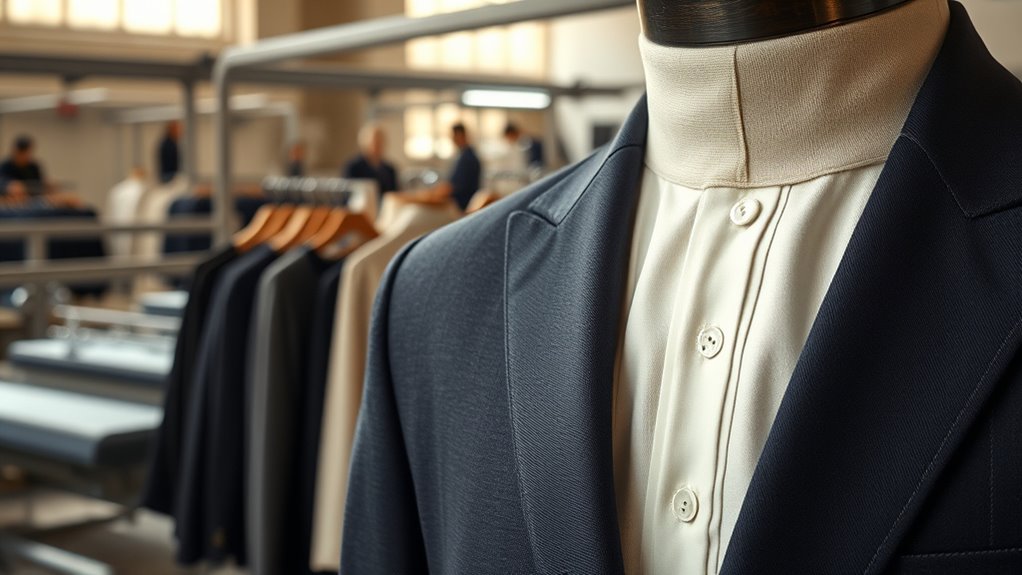
When it comes to craftsmanship and the quality of materials, designer brands often prioritize meticulous attention to detail and sourcing premium fabrics. You’ll notice their dedication to superior fabric sourcing, choosing only the finest textiles that enhance durability and appearance. Skilled artisans employ precise tailoring techniques, ensuring each piece fits perfectly and showcases impeccable construction. From hand-stitched seams to carefully selected trims, every element reflects a commitment to excellence. Unlike fast fashion, where mass production can compromise quality, designer labels focus on enduring quality and refined craftsmanship. This attention to detail results in garments that not only look luxurious but also stand the test of time. When you invest in designer pieces, you’re paying for craftsmanship rooted in tradition and the best materials available.
Production Processes and Manufacturing Standards
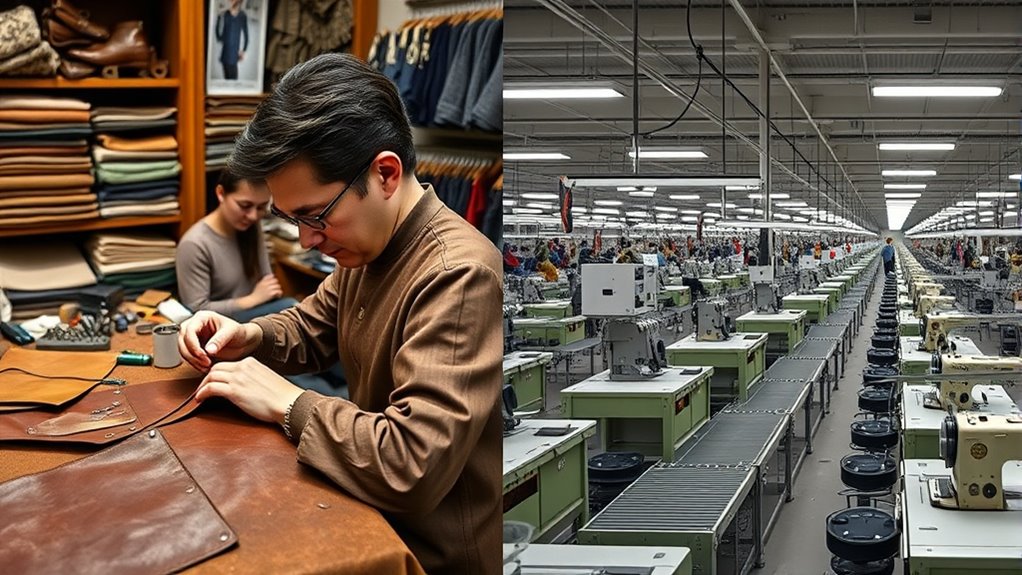
Unlike fast fashion, which often relies on large-scale, automated production lines, designer brands emphasize careful control over their manufacturing processes. This focus guarantees high standards and meticulous craftsmanship, setting them apart from mass production and rapid manufacturing methods. Designer brands prioritize quality over speed, often producing limited quantities to maintain exclusivity. Their production standards involve detailed oversight, use of premium materials, and skilled labor, which contribute to superior durability and craftsmanship. Additionally, many designer brands incorporate artisanal techniques into their manufacturing, ensuring each piece reflects a high level of skill and attention to detail. This commitment to manufacturing standards underscores their dedication to excellence and reinforces their reputation for quality. Furthermore, their emphasis on ethical practices and sustainable sourcing further distinguishes them from fast fashion, aligning with the values of discerning consumers who seek authenticity and responsibility in their luxury pieces. Incorporating rigorous quality control processes, these brands ensure each item meets strict standards before reaching consumers, often involving sustainable sourcing practices that promote environmental responsibility.
Brand Heritage and Legacy

Have you ever considered how a brand’s history shapes its identity? Brand heritage and legacy carry significant weight in luxury fashion, reflecting their historical significance and cultural influence. These brands often have stories that span decades or even centuries, showcasing craftsmanship and innovation that set them apart. Their legacy isn’t just about reputation; it’s about the values, traditions, and artistry rooted in their origins. This historical significance is often demonstrated through iconic designs and pioneering techniques passed down through generations. This deep sense of history attracts loyal customers who appreciate authenticity and craftsmanship. Unlike fast fashion, which focuses on quick trends, luxury brands leverage their heritage to create an emotional connection, reinforcing their prestige and timeless appeal. Additionally, brand reputation is often built upon this rich history, further elevating their status in the fashion industry. Their ability to maintain timeless appeal through generations is a testament to the enduring power of their legacy. Furthermore, many of these brands invest in heritage preservation, ensuring that their traditions are passed on and continue to influence modern designs. Your perception of a brand’s worth is often intertwined with its legacy, making history an essential element of luxury fashion’s distinctiveness.
Exclusivity and Limited Availability
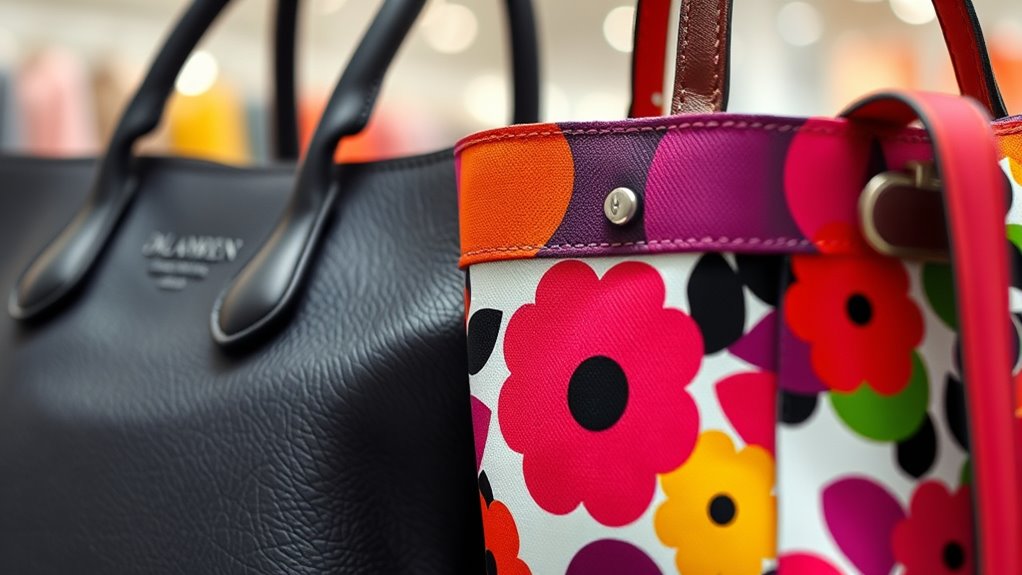
Exclusivity and limited availability are at the core of a luxury brand’s allure, creating a sense of rarity that appeals to discerning customers. When you gain exclusive access to limited editions, you’re part of an elite group that values uniqueness over mass-produced items. Limited runs and special collaborations ensure that your piece remains rare, elevating its status. This scarcity fuels desire and justifies the premium pricing associated with luxury fashion. By offering limited editions, brands foster loyalty among dedicated clients who appreciate the effort behind exclusivity. You’re not just buying a product; you’re investing in something that stands out and holds value over time. Additionally, monitoring the tanning sessions and adjusting them based on skin type can help maintain skin health and prolong the quality of your tan. Understanding brand reputation and consumer perception helps luxury brands maintain their prestige, making each piece more than just clothing—it’s a symbol of distinction and exclusivity, which enhances its desirability and perceived value.
Sustainability and Ethical Practices

As awareness of environmental and social issues grows, sustainability and ethical practices have become key considerations for many consumers when choosing fashion brands. You now look for brands that prioritize sustainable sourcing, ensuring materials are responsibly harvested with minimal environmental impact. Ethical labor is equally important; you want to support companies that treat workers fairly, offer safe working conditions, and pay fair wages. Luxury fashion brands often lead in these areas, implementing strict standards and transparency measures. Additionally, many luxury brands are pioneering sustainable sourcing initiatives that set industry benchmarks. These brands frequently incorporate eco-friendly materials like organic cotton, recycled fabrics, and sustainable dyes to further their environmental commitments. Consumers are increasingly aware of supply chain transparency, which helps ensure that ethical practices are maintained throughout production. Fast fashion, on the other hand, frequently neglects these practices, prioritizing low costs over ethical concerns. By choosing brands committed to sustainability and ethical labor, you contribute to reducing environmental harm and supporting fair treatment across the supply chain. Your choices can drive positive change in the industry. Understanding sustainability can help consumers make more informed decisions about the brands they support.
Price and Perceived Value
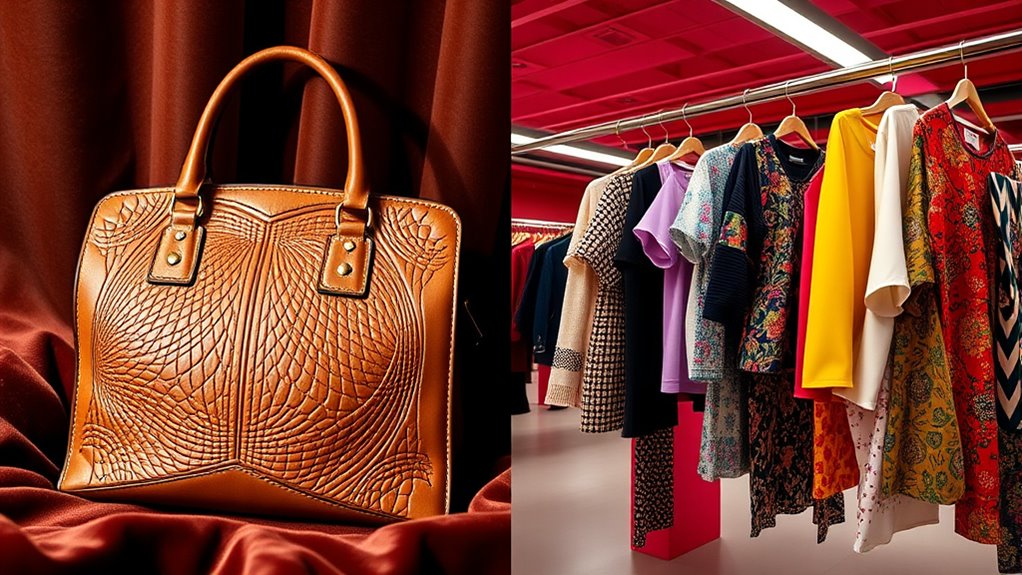
Why do some fashion brands seem worth their price while others don’t? It comes down to their pricing strategies and how they craft perceived luxury. Luxury brands position their products as exclusive, emphasizing quality, craftsmanship, and heritage, which justifies higher prices. This creates a perception of rarity and status. Fast fashion, on the other hand, keeps prices low by using cheaper materials and mass production, which diminishes perceived value. Additionally, luxury brands often leverage brand reputation and storytelling to reinforce their image of exclusivity and prestige. Key factors include:
Luxury brands justify higher prices through exclusivity, craftsmanship, and heritage, creating a perception of rarity and elevated status.
- Premium pricing that signals exclusivity and quality
- Consistent branding that reinforces perceived luxury
- Limited editions or bespoke options that boost perceived rarity
Furthermore, the use of color accuracy and meticulous calibration in luxury branding materials helps maintain a consistent and premium visual identity. When consumers associate a brand with perceived value, it enhances their overall perception of the product’s worth. In addition, the strategic use of visual branding and high-quality imagery plays a vital role in shaping consumer perceptions. Ultimately, it’s about how a brand manages perception—luxury brands elevate their offerings to seem more valuable, even if the actual cost of production is comparable.
Consumer Perception and Status Symbol

Consumer perception plays a central role in how fashion brands are valued and the status they confer. When you see celebrities sporting luxury labels on social media, it elevates the brand’s image and signals social standing. Fast fashion, while accessible, often lacks this perceived exclusivity, making it less of a status symbol. In contrast, designer pieces are seen as symbols of success and taste, reinforced by celebrity influence and curated social media content. This dynamic shapes your view of what’s fashionable and prestigious. Additionally, trends like ONE2CRYPTO highlight how market shifts and regulatory developments can influence perceptions of value and exclusivity in various industries. Recognizing the influence of market volatility on luxury branding can further deepen understanding of how exclusivity is maintained and perceived.
Innovation and Design Philosophy

You notice that designer brands often prioritize artistic vision and creativity, pushing boundaries to create unique pieces. They emphasize craftsmanship, valuing quality and detail that set their work apart. In contrast, fast fashion tends to focus on quick, trendy designs, often sacrificing originality for mass appeal.
Artistic Vision and Creativity
Artistic vision and creativity drive the core differences between designer and fast fashion. As a designer, you focus on conceptual storytelling and push boundaries with avant-garde techniques, transforming ideas into wearable art. Your approach emphasizes innovation, often challenging traditional norms to craft unique, thought-provoking pieces. Fast fashion, however, prioritizes quick turnaround and mass appeal, often lacking the depth of creative exploration.
- You experiment with bold, unconventional materials and forms to express your vision.
- Your designs reflect a narrative or concept, making each piece meaningful.
- You embrace avant-garde techniques to set trends rather than follow them, fostering originality.
This commitment to artistic integrity shapes the distinct worlds of luxury design and fast fashion, defining what truly sets them apart.
Emphasis on Craftsmanship
While both designer and fast fashion brands prioritize innovation, their approaches to craftsmanship and design philosophy differ markedly. Designers focus on meticulous tailoring techniques and artisan collaborations to create unique, high-quality pieces. They invest time in perfecting every detail, emphasizing durability and exclusivity. Fast fashion, however, often sacrifices craftsmanship for rapid production, relying on mass manufacturing and standardized techniques. The table below highlights these differences:
| Aspect | Designer Fashion | Fast Fashion |
|---|---|---|
| Tailoring Techniques | Precise, handmade adjustments | Machine-based, generic fits |
| Artisan Collaborations | Close partnerships with skilled artisans | Limited or absent collaborations |
| Design Philosophy | Emphasis on craftsmanship and detail | Focus on speed and affordability |
This contrast defines how each prioritizes quality and creativity.
Frequently Asked Questions
How Do Designer and Fast Fashion Brands Target Different Customer Segments?
You see, designer brands target a niche segment by emphasizing brand loyalty and exclusivity strategies, making their pieces feel unique and aspirational. They use limited editions and personalized experiences to attract high-end consumers. In contrast, fast fashion brands aim for mass appeal, offering trendy, affordable items to a broader audience. Their focus is on quick turnover and accessibility, which appeals to customers seeking variety and affordability over exclusivity.
What Role Does Marketing Play in Shaping Brand Perception?
Marketing shapes your brand perception through powerful brand storytelling that connects emotionally and highlights your uniqueness. Influencer collaborations amplify your message, making your brand more relatable and desirable. You actively use these strategies to craft a compelling narrative that resonates with your audience, fostering loyalty and elevating your brand’s status. By consistently telling your story and partnering with influential figures, you influence how consumers perceive your luxury or fast fashion brand.
How Do Supply Chains Differ Between Luxury and Fast Fashion Brands?
You’ll notice that luxury brands prioritize supply chain transparency, ensuring you see their sourcing strategies and craftsmanship details. They often work with smaller, carefully selected suppliers, emphasizing quality and ethical practices. Fast fashion brands, on the other hand, focus on quick turnaround times with less transparency, sourcing cheaper materials from global suppliers. This difference impacts product quality, sustainability, and how you perceive the brand’s commitment to ethical fashion.
In What Ways Do Customer Service Experiences Vary?
You’ll find luxury brands offer personalized approaches to customer service, making you feel valued through tailored shopping experiences and exclusive perks. Their after-sales support is thorough, ensuring your satisfaction long after purchase with services like repairs and dedicated assistance. In contrast, fast fashion brands often prioritize quick transactions and may lack the personalized touch or extensive after-sales support, focusing more on volume than building lasting relationships with customers.
How Do Seasonal Collections Influence Consumer Buying Behavior?
Like the shifting tides of the seasons, your buying psychology is influenced by seasonal trends, sparking anticipation and exclusivity. When collections change, you’re prompted to act quickly, driven by the desire to stay current and unique. This sense of urgency boosts your engagement, making you more likely to make impulsive purchases. Seasonal collections create a dynamic environment, encouraging you to align your style with the latest fashion moments.
Conclusion
Ultimately, what truly sets luxury fashion apart isn’t just the craftsmanship or exclusivity—it’s the story it tells and the emotions it stirs. As you explore designer pieces versus fast fashion, you realize it’s more than material or price; it’s a journey into legacy, innovation, and meaning. Are you ready to discover what resonates with your identity? The choice isn’t just about fashion—it’s about what you want to leave behind.


